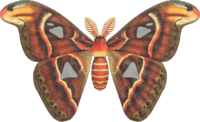Atlas moth
| ||||||||
 | ||||||||
| Real-world info | ||||||||
|---|---|---|---|---|---|---|---|---|
| Name: Attacus atlas Family: Saturniidae | ||||||||
| Main appearances | ||||||||
|
| ||||||||
| Other appearances | ||||||||
Names in other languages
ヨナグニサン
皇蛾 Attacus Atlas Polilla atlas Farfalla cobra Павлиноглазка атлас
아틀라스나방 皇蛾 Attacus Atlas Polilla atlas Atlasspinner Atlasvlinder | ||||||||
The Atlas moth[nb 1] is a bug in the Animal Crossing series. The Atlas moth first appeared in Animal Crossing: New Horizons and was later added to Animal Crossing: Pocket Camp. It is a huge moth that is similar to the oak silk moth from previous games, for which it is a replacement.
In the games that the Atlas moth appears in, it is a rare bug that the player can encounter, and can be found on trees during the night. In Animal Crossing: New Horizons, it can be caught from mid spring to the start of fall.
Catch details[edit]
In Pocket Camp[edit]
| Availability | Not currently available
|
|---|---|
| Location | |
| Size | 303.6 mm – 336.4 mm |
| Rarity | ★★★ |
| Selling price | |
| Version added | 3.1.2 |
| Villager gift data | Tier: 3 (Uncommon+)
Rewards:
|
In New Horizons[edit]
| Time of year | North: Apr – Sep South: Oct – Mar |
|---|---|
| Time of day | 7 PM – 4 AM |
| Location | On trees (any kind) |
| Weather | Any weather |
| Spawn requirement | Catch 20 total bugs |
| Selling prices | |
| Furniture size |
Donating to the museum[edit]
In New Horizons[edit]
Blathers has this to say about the Atlas moth:
Commissioning a model[edit]
In Animal Crossing: New Horizons, if the player brings three Atlas moths to Flick to commission a model, he will say the following:
"R-really? You want a sculpture of an Atlas moth? The ghost who flutters like a bug? Their brief lives are a tragedy that no one will ever hear, for they have no mouths to tell it! I promise this will be my silent-est masterpiece, and I shall title it The Grand Atlas Moth!"
Gallery[edit]
Real-world information[edit]
The Atlas moth is one of the largest lepidopterans with a wingspan measuring up to 24 cm (9.4 in) and a wing surface area of about 160 cm2 (~25 in2). It is only surpassed in wingspan by the white witch (Thysania agrippina) and in wing surface area by the Hercules moth (Coscinocera hercules). As in most Lepidoptera, females are noticeably larger and heavier than males, while males have broader antennae.
The body is disproportionately small compared to the wings. The upperside of the wings are reddish brown with a pattern of black, white, pink, and purple lines and triangular, scale-less windows bordered in black. The undersides of the wings are paler. Both forewings have a prominent extension at the top.
The Atlas moth has no mouth; every flight takes valuable energy and can take days off their already short lives, as it has a very short life span of only one to two weeks. They conserve energy by flying as little as possible. A female will wait for a male to come along and be fertilised, lay eggs and die.
Atlas moths are a saturniid moth, a group that includes the famous luna moth. Despite what their common name suggests, they are only distant cousins of the domestic silk moth (Bombyx mori) which belong to the family Bombycidae.
More information on this topic is available at Wikipedia.
Names in other languages[edit]
| ヨナグニサン yonagunisan |
Name of subspecies A. atlas ryukyuensis, lit. "Yonaguni silkmoth" | |
| 아틀라스나방 ateullaseunabang |
Atlas moth | |
| 皇蛾 huáng-é |
Atlas moth (lit. "royal moth") | |
| Павлиноглазка атлас Pavlinoglazka atlas |
Atlas moth | |
| Atlasvlinder | Atlas moth (lit. "Atlas butterfly") | |
| Atlasspinner | Atlas moth | |
| Polilla atlas | Atlas moth | |
| Attacus Atlas | From scientific name | |
| Farfalla cobra | Atlas moth (lit. "cobra butterfly") | |
Notes[edit]
| Bugs | ||||||||||||||||||||||||||
|---|---|---|---|---|---|---|---|---|---|---|---|---|---|---|---|---|---|---|---|---|---|---|---|---|---|---|
| ||||||||||||||||||||||||||
| Pocket Camp bugs | ||||||||||||||||
|---|---|---|---|---|---|---|---|---|---|---|---|---|---|---|---|---|
| ||||||||||||||||

